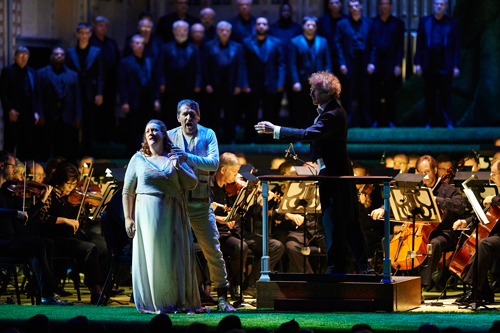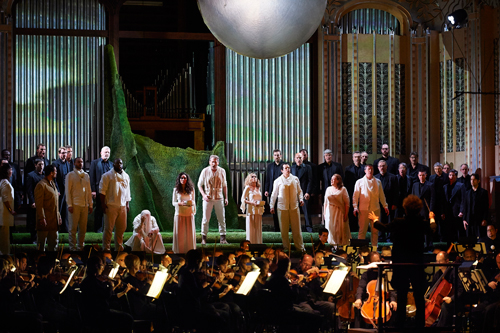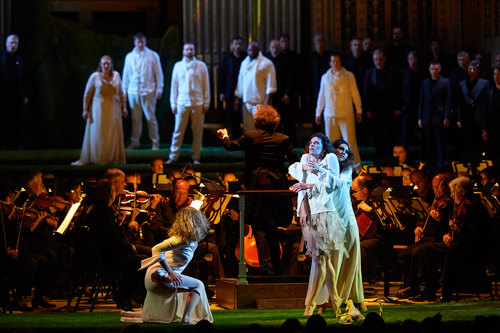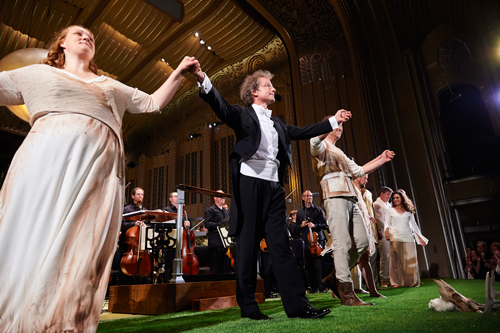by Daniel Hathaway
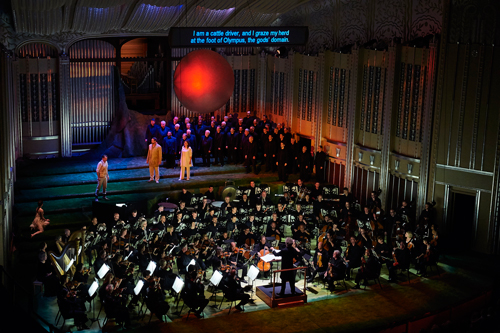
Franz Welser-Möst, The Cleveland Orchestra, the men of the Cleveland Orchestra Chorus, and a distinguished cast of soloists delivered an expertly-paced, musically stunning performance of Daphne, Strauss’s 90-minute “bucolic tragedy in one act” on Wednesday, May 27 (repeated on Saturday, May 30). James Darrah stage directed the production, sharing choreographic credit with the featured dancer, Bryna Pascoe.
Here’s the story: Daphne, the daughter of the river god Peneios and the earth goddess Gaea, spurns the lustful attentions of her childhood friend Leukippos in favor of the chaste allure of nature. The sun god Apollo drops into a Dionysian orgy disguised as a cowherd and is besotted with Daphne (to complicate things further, he turns out to be her brother!). Leukippos sneaks into the revels as a woman, wearing a dress intended for Daphne. Apollo blows the whistle on Leukippos and reveals his own divinity, jealously killing Leukippos with an arrow. Apollo, feeling remorse, arranges for Zeus to turn Daphne into a laurel tree whose leaves will adorn only the brows of heroes.
The Cleveland Orchestra was front and center in this production, occupying as prominent a position onstage as it does in the drama itself. In Strauss’s opulent, evocative score, the orchestration embraces the singers, to be sure, but long descriptive passages are given to the orchestra alone. They played the entire score with transparency and an ease that belied its many difficulties. Oboist Frank Rosenwein and flutist Joshua Smith embroidered the musical texture with archetypical Greek instrumental sounds (Leukippos is a flute player), and concertmaster William Preucil contributed important solos throughout the opera.
The stage setup seemed dangerous for vocal-orchestral balances, but this group of principals had heft enough to be heard over the densest orchestration, even when deployed on the upstage platform. Regine Hangler was both pure and puissant of voice as Daphne. Andreas Schager made for a commanding Apollo, and Ain Anger a powerful Peneios. If tenor Norbert Ernst (Leukippos) might have been slightly underpowered by comparison, his clarity of voice and deft acting suited his character well. As Gaea, Nancy Maultsby negotiated some alto profundo notes with resonance and grace.
The male chorus sang its commentaries with presence and dramatic import, and minor roles were ably handled by Christopher Feigum, Matthew Plenk, Ryan Speedo Green, Nikola Budimir, Lauren Snouffer, and Anya Matanovic.
Some aspects of the production were effective, others frankly puzzling. The Severance Hall stage was covered with artificial grass that extended into the center opening of the organ chamber, whose pipes had been removed for no apparent reason. A big hemisphere above the orchestra represented both sun and moon under different lighting.
Though the characters are all shepherds (or pretending to be), the male chorus was dressed in black suits, with a small contingent of white-garbed singers milling among them menacingly at the beginning, resembling a scene from a futuristic thriller (La Femme Nikita?). Apollo and Penelos looked as though they were dressed for grouse hunting on an English country estate.
Dancer Bryna Pascoe became (among other things) Daphne’s alter ego, engaging in mysterious pantomime up and downstage as the story unfolded. Belying Strauss’s overheated music, the staging of the Dionysian revel was strangely calm, then turned creepy when the women seemed to be forcing Greek yogurt into the dancer’s mouth. Late in the opera, the male chorus turned upstage, wearing curious masks on the backs of their heads.
One important piece of staging cried out for more imagination. Of Daphne’s transformation, Ovid writes:
Her prayer was scarcely done when a heavy numbness seized her limbs, thin bark closed over her breast, her hair turned into leaves, her arms into branches, her feet so swift a moment ago stuck fast in slow-growing roots, her face was lost in the canopy. Only her shining beauty was left. (Translation by A.S. Kline)
At Severance Hall, as Strauss’s music became more and more disembodied and Daphne’s wordless voice drifted out from behind the organ pipes, the dancer slowly drew a long strip of cloth out of a slit in the grassy carpet, wound it around herself from neck to ankles and then slithered out of all her clothing, lying down naked on the stage (there was a body stocking involved). Something closer to Ovid’s description would have been made a memorable visual impression at the end of this excellent evening of music.
Photos by Roger Mastroianni.
Published on ClevelandClassical.com June 2, 2015.
Click here for a printable copy of this article


